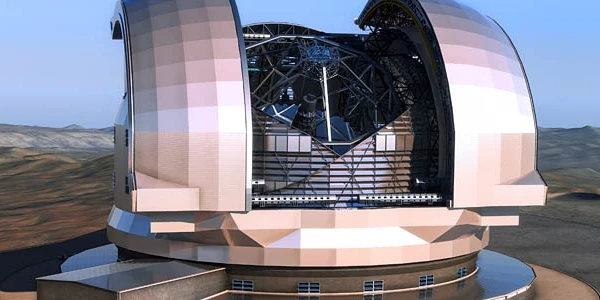
The E-ELT (European Extremely Large Telescope) represents a major technological breakthrough in ground-based astronomy. With its 39-meter primary mirror, this observation giant pushes the boundaries of what is technologically possible. Located on Cerro Armazones in the Atacama Desert, Chile, at an altitude of 3,060 meters, it benefits from exceptional observing conditions with over 320 clear nights per year.
The E-ELT's design is based on an innovative five-mirror Ritchey-Chrétien telescope architecture. Its primary mirror, composed of 798 hexagonal segments (each 1.4 meters wide), is an engineering feat. The advanced adaptive optics system compensates for atmospheric turbulence, achieving an angular resolution of up to 0.005 arcseconds—fifteen times sharper than the Hubble Space Telescope.
The E-ELT is designed to address some of modern astronomy's most fundamental questions. Key objectives include detecting and characterizing Earth-like exoplanets in the habitable zones of their stars, studying the formation and evolution of the first galaxies, measuring the acceleration of the Universe's expansion, and analyzing supermassive black holes in detail.
A flagship project of the ESO (European Southern Observatory), the E-ELT is the result of collaboration between fifteen member countries and several international scientific institutions. The total project cost is estimated at €1.3 billion. First light is expected in 2027, with full operational capability by 2030.
The E-ELT is a giant telescope under construction in Chile's Atacama Desert. Its primary mirror spans nearly 39 meters in diameter, allowing it to capture vast amounts of light and observe distant stars, planets around other suns, and even galaxies formed shortly after the Big Bang.
The heart of the E-ELT is a mirror made up of nearly 800 hexagonal segments. Small motors constantly adjust them to maintain a perfect surface, even when wind blows or temperatures vary. This mirror, combined with four others, forms an ingenious optical system that delivers sharp images across a wide field of view.
When observing stars from the ground, air causes light to twinkle and blurs details. The E-ELT uses a technique called AO: sensors continuously analyze atmospheric disturbances, and a flexible mirror corrects them in real time. Thus, images are nearly as precise as if the telescope were in space.
| Telescope | Primary diameter (m) | Collecting area (m2) | Notes |
|---|---|---|---|
| European Extremely Large Telescope (E-ELT) | ≈ 39 | ≈ 978 | Segmented mirror (~798 segments), 5-mirror system, highly advanced adaptive optics. |
| Thirty Meter Telescope (TMT) | 30.0 | ≈ 655 | Segmented design; Mauna Kea site. |
| Giant Magellan Telescope (GMT) | 25.4 | ≈ 368 | Seven large monolithic mirrors combined; under construction. |
| Large Binocular Telescope (LBT) | Equivalent 11.8 (2 × 8.4) | ≈ 111 | Two 8.4-meter mirrors; combined for better resolution. |
| Gran Telescopio Canarias (GTC) | 10.4 | ≈ 85 | Segmented mirror; one of the largest optical telescopes in operation. |
| Southern African Large Telescope (SALT) | ≈ 11 | ≈ 90 | Large segmented telescope in South Africa; excellent for spectroscopy. |
| Keck I & Keck II | ≈ 10 | ≈ 75 | Twin telescopes on Mauna Kea; excellent adaptive optics. |
| Subaru Telescope | 8.3 | ≈ 54 | Large Japanese telescope on Mauna Kea; wide field of view. |
| Very Large Telescope (VLT) | 4 × 8.2 (units) or individual 8.2 | ≈ 53 per unit | Four individual telescopes in Chile; can be used separately or combined. |